- Bitcoin's slide continues
- US dollar, gold both marginally higher
- Oil is struggling
Key Events
After one of the worst weeks for US markets since the start of the global pandemic in March 2020, US futures on the Dow Jones, S&P 500, NASDAQ and Russell 2000 traded higher in pre-US open trading on Monday, only to lose positive momentum and slide back into negative territory.
Yields on the 10-year Treasury note also slipped as investors returned to buying US government bonds.
Global Financial Affairs
US futures have been volatile in trading ahead of the Wall Street open, wavering from positive to negative territory as markets await any information from this week's Federal Reserve meeting—when markets expect the US central bank to confirm it will finish tapering in March and begin hiking rates.
Investors are also eagerly awaiting earnings from some mega-cap tech names, including IBM (NYSE:IBM) which reports after the close today and Apple (NASDAQ:AAPL), which reports on Thursday, to see if they can glean any information on the global economic outlook.
The STOXX 600 Index was trading over 2% lower this morning, putting it on track for its worst two-day drop since November 2020. Tightening monetary policies tend to hit growth stocks first, as they typically have higher valuations. The expectation that the Fed will indicate a March interest rate hike to quell US inflation may result in stocks sliding even further as the rising cost of money leads investors to reprice the value of assets.
Another worry for markets to contend with is a possible Russian invasion of Ukraine.
In Europe, technology stocks fell to a 14-week low. Even car manufacturers Renault (PA:RENA), Nissan (T:7201) and Mitsubishi (T:7211) all slipped though they are planning to triple their investment to jointly develop electric vehicles.
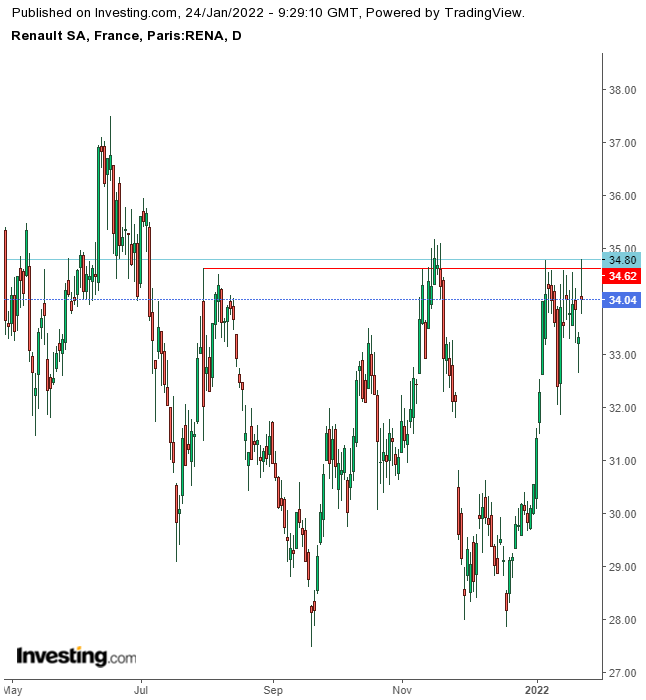
The French car manufacturer's stock advanced 4.46% to $34.80, nearing its highest level since July. However, the resistance of the peak price levels since then pushed the price back lower.
Unilever (NYSE:UL) jumped 4.6% on the news that Trian Partners, Nelson Peltz's activist hedge fund has built a position in the consumer goods firm but shares then slid into negative territory.
Vodafone (LON:VOD) jumped over 5% after a report that the telecom operator is in talks with Iliad to combine their respective Italian businesses.
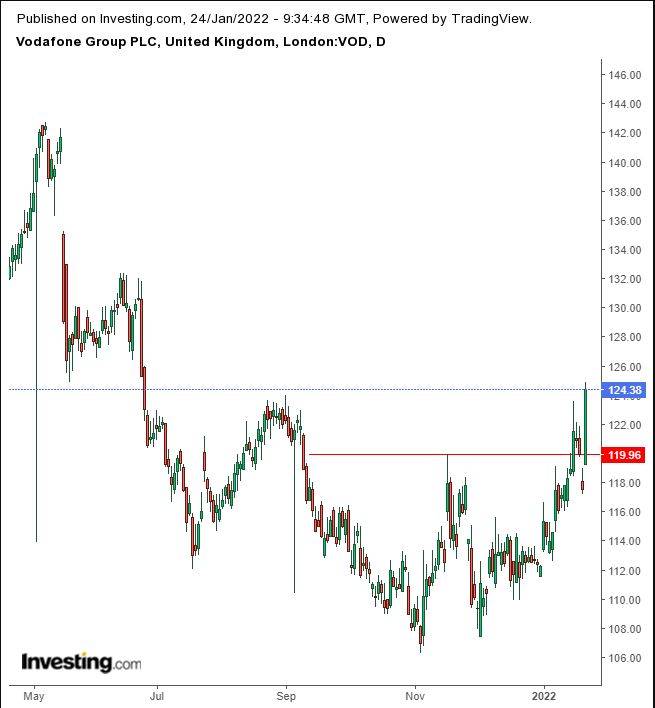
The rally helped the stock bottom out.
Most Asian stocks declined on Monday, led by South Korea's KOSPI which dropped 1.5%. As one of the world's most innovative countries, South Korea's stocks are sensitive to the technology sector selloff. On the other hand, Japan's economy is more invested in manufacturing than high tech. Accordingly, Japan's Nikkei outperformed, rising 0.25%
Keeping an eye on US 10-year Treasuries and how they react to any US policy shift may provide clues to investors' plans for equities.
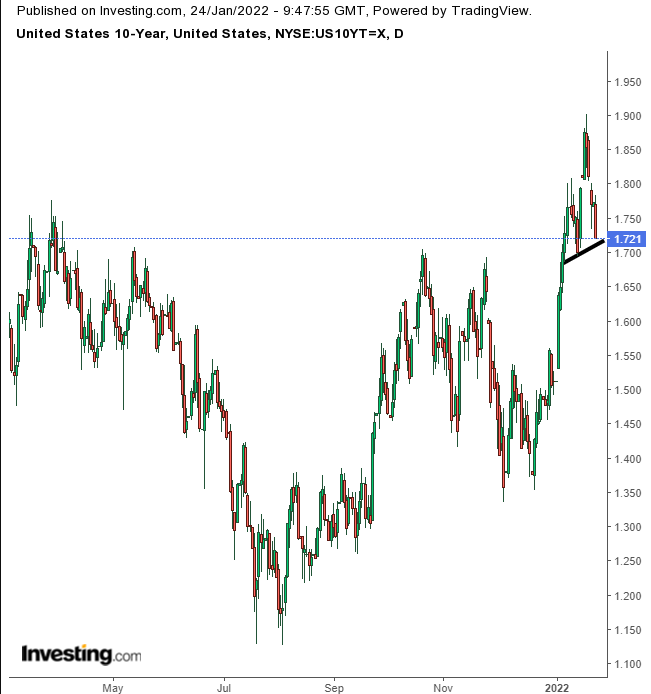
Yields are trading on a small top on a crucial support-resistance area going back to the March peak.
The dollar was in positive territory, but only just, as traders are waiting for a new catalyst.
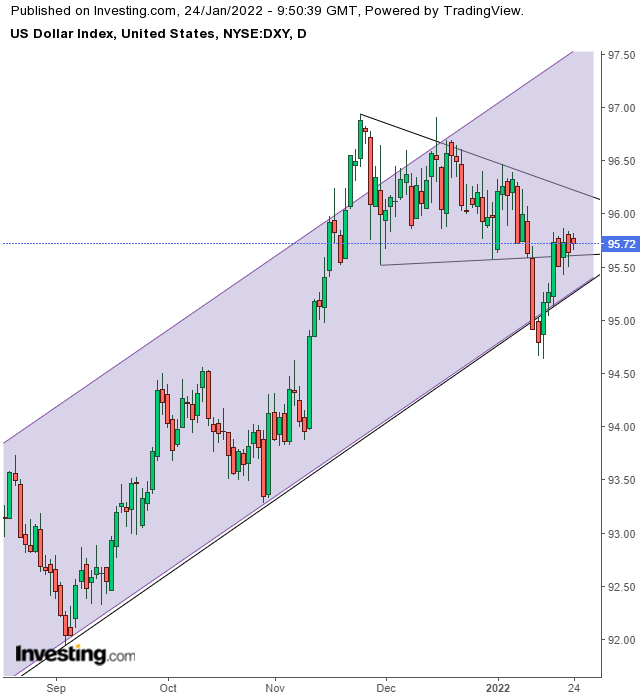
The greenback is on the fence in the form of an Ascending Triangle bottom after bouncing off the bottom of a rising channel. An Ascending Triangle occurs when sellers drown out buyers and reduce prices to find new willing buyers at lower price levels.
If the dollar falls below the mid-January low, it will likely extend the decline. Alternatively, if the price blows out the triangle, the rising channel is expected to resume, and the price will test the Nov. 4 peak.
Gold edged higher, testing the resistance of a range top.

The price neared the top of a triangle going back to August after the yellow metal scored its first record high in years.
Bitcoin broke the $35,000 level, and if it closes below, it will have done so for the first time since July. The cryptocurrency is halfway to our target, where it awaits another test which could take it much further down.
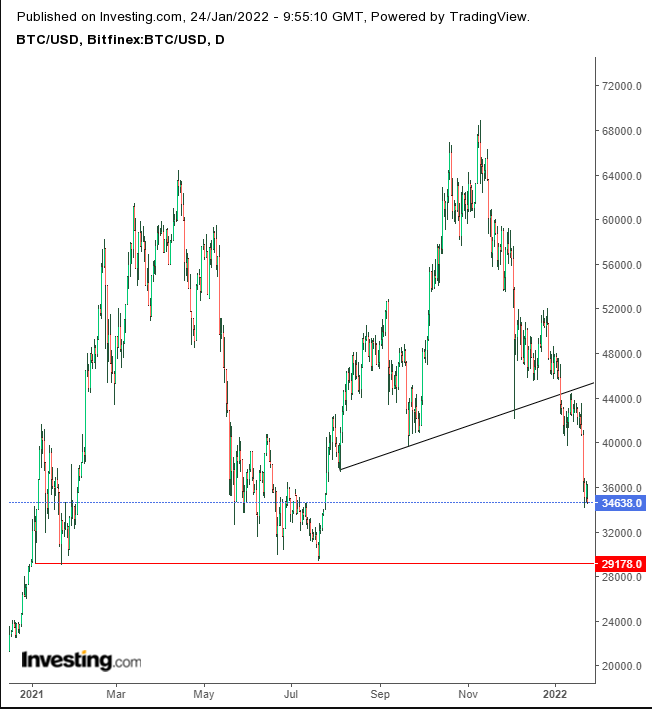
The leading crypto is extending the price penetration following an H&S top as it heads for the neckline of a much larger double-top.
After a strong recovery since the middle of December last year, oil is finding it difficult to develop an uptrend at the resistance of the previous peak.
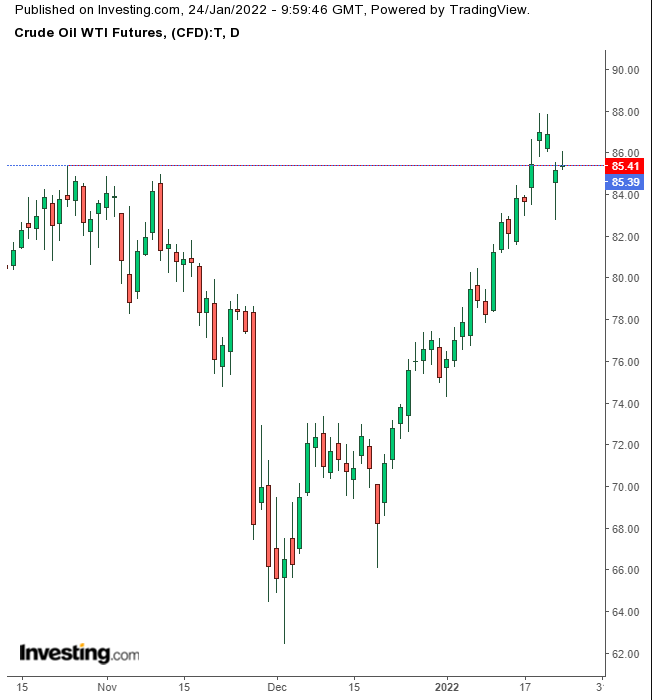
The rally in prices has been one of the contributors to recent inflationary pressures so any movements can significantly impact the broader market.
Up Ahead
- US CB Consumer Confidence is published on Tuesday.
- On Wednesday EIA crude oil inventory report.
- On Thursday, US fourth-quarter GDP data is announced.
Market Moves
Stocks
- The STOXX 600 fell 1.3%
- The MSCI Asia Pacific Index fell 0.7%
- The MSCI Emerging Markets Index fell 1.3%
Currencies
- The Dollar Index was little changed
- The euro fell 0.3% to $1.1303
- The Japanese yen rose 0.1% to 113.79 per dollar
- The offshore yuan fell 0.2% to 6.3268 per dollar
- The British pound fell 0.48% to $1.3489
Bonds
- The yield on 10-year Treasuries declined three basis points to 1.73%
- Germany's 10-year yield fell three basis points to -0.09%
- Britain's 10-year yield fell five basis points to 1.12%
Commodities
- WTI crude is up 0.26% at $85.41 a barrel
- Brent crude rose 0.01% to $87.09 a barrel
- Spot gold rose 0.3% to $1,841.29 an ounce
